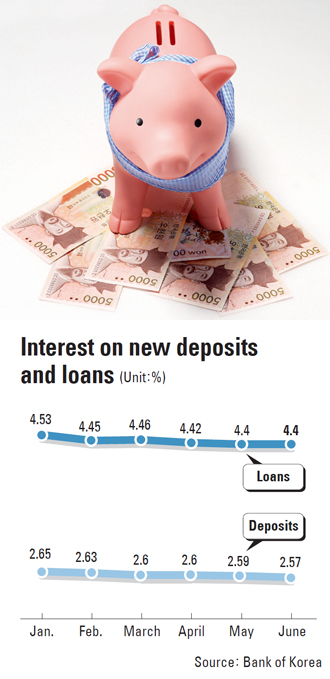Interest on deposits hits new low

Interest rates could further retreat as speculation grows that the central bank might lower the key policy rate as early as next month.
According to the Bank of Korea yesterday, the average interest on fresh deposits last month was at 2.57 percent. This is 2 basis points lower than the previous month. Based on data the central bank has been collecting since 1996, the interest rate has been continuously falling to a new low since reporting an average of 2.6 percent in April.
The average rate on savings accounts was 2.56 percent while the interest on financial products was 2.67 percent.
This means that when incorporating taxes and the inflation rate, a person will be losing money in his or her savings account.
According to the report, most of the annual interest on existing deposits is in the 2 percent range, accounting for 96 percent. Deposits with an annual interest of 3 percent accounted for 0.8 percent, which is the smallest ever. Deposits with at least 3 percent interest made up 73 percent until 2012.
Interest on debts remained the same as the previous month. The average rate for a new loan was 4.4 percent. This was largely because the rate on corporate loans went up while the interest rate on household debt was pushed down to its lowest level largely because of increased demand for fixed-interest loans and government loan support programs.
The average interest rate on household debt fell 8 basis points from the previous month to 3.94 percent. Mortgage loan interest was 5 basis points lower than May at 3.58 percent.
This is the first time where household debt interest has fallen to the 3 percent range. On the contrary, corporate loan interest compared to May added 3 basis points to 4.53 percent last month.
The drop in interest rates is raising concern at banks as most deposit products offered by major banks such as Woori and Hana have fallen to the 1 percent level.
“Deposits have been losing their appeal and the situation is getting much worse especially since more products with a 1 percent interest rate will be rolling out once the central bank lowers the key interest rate,” said a banking official, who requested anonymity. “We’re in a difficult situation because to generate profit we would have to lower deposit interests as loan interests will be lowered once the central bank cuts the policy rate. Under these circumstances, we will be losing more of our customers to nonbanking financial companies.”
In the meantime, the government is encouraging people looking to borrow money to switch from nonbanking financial institutions, which apply higher interest rates, to banks.
The Financial Supervisory Service said yesterday that starting Friday, the loan-to-value ratio and debt-to-income ratio applied to mortgage loans will be used regardless of the financial institution.
Starting Aug. 1, the same LTV and DTI ratios will be applied to banks and nonbanking financial companies. Currently, a 50 to 60 percent ratio is applied to LTV loans whereas nonbanking financial companies such as savings banks and credit unions have a higher ratio of 60 to 70 percent.
As a result, banks have had trouble attracting customers who want to take out heftier loans. Instead, most customers turn to nonbanking financial companies, which add at least 1 percentage point to the interest rate. While most banks’ loan interests are in the mid-3 percent range, nonbanking financial companies usually have an interest rate of closer to 5 percent.
BY lee ho-jeong [ojlee82@joongang.co.kr]










with the Korea JoongAng Daily
To write comments, please log in to one of the accounts.
Standards Board Policy (0/250자)